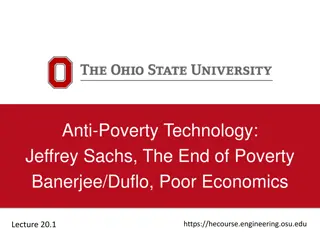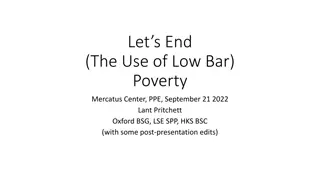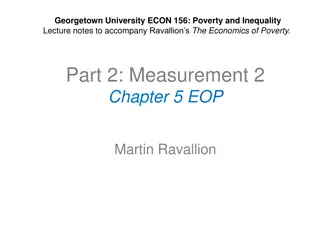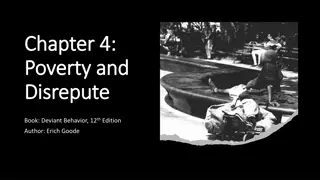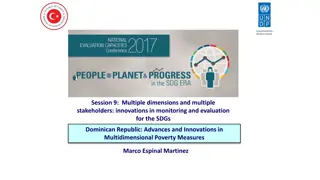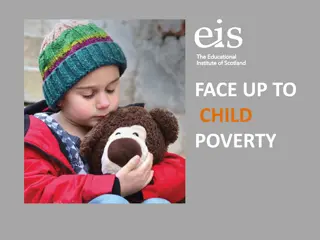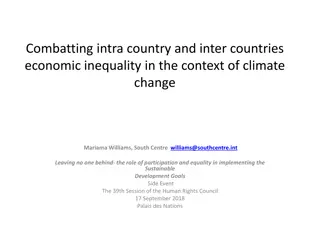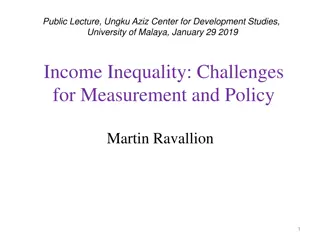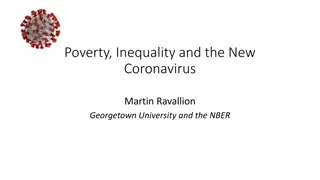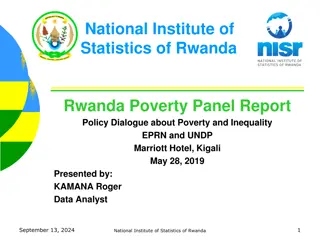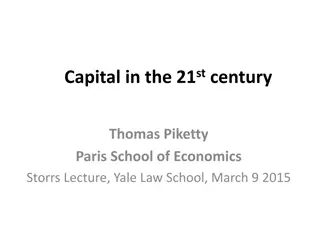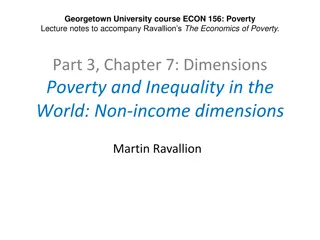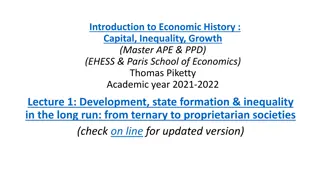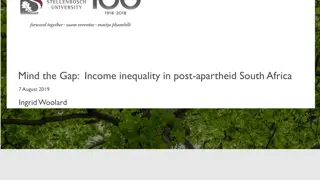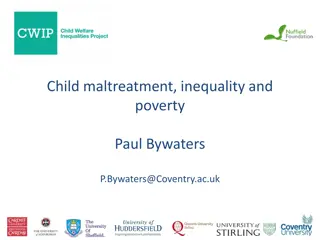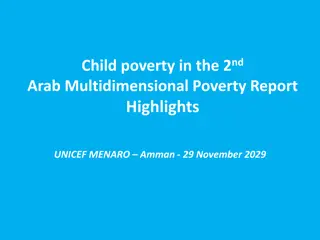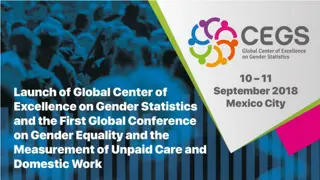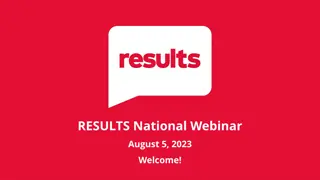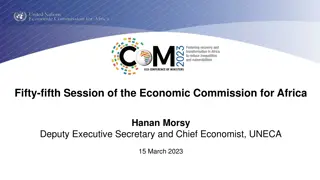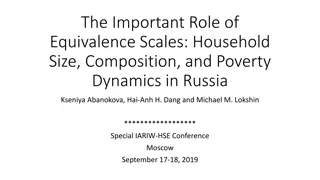Understanding Poverty and Inequality: A Recap and Conclusions
The course recap delves into the historical and current debates on poverty and inequality globally, spanning economic theories and evidence. It highlights progress in reducing absolute poverty but challenges in addressing relative poverty and inequalities within and between countries, emphasizing the evolving models of poverty over time. The discourse explores the necessity of policies to combat poverty traps and societal attitudes towards wealth and poverty.
Download Presentation

Please find below an Image/Link to download the presentation.
The content on the website is provided AS IS for your information and personal use only. It may not be sold, licensed, or shared on other websites without obtaining consent from the author. Download presentation by click this link. If you encounter any issues during the download, it is possible that the publisher has removed the file from their server.
E N D
Presentation Transcript
Georgetown University ECON 156: Poverty and Inequality Recap and Conclusions Martin Ravallion (Reading: EOP Conclusions)
Recap The course has introduce you to the main past and present debates about poverty and inequality in the world. The debates are in large part about economics, though they also reach into other fields. The issues span all areas of economics, from macro to micro, from theory to evidence, from poor countries to rich ones. Economics is, in essence, the study of poverty. Max Hartwell
Global poverty and inequality: A summary How are we doing globally? Overall progress in reducing the incidence of extreme absolute poverty. Less progress for relative poverty, and in assuring that none are left behind. Poverty Inequality Falling Rising Rising Falling Absolute Relative Note: Poverty measured by counts of people living in income-poor households. Inequality measured in terms of incomes or consumptions. Relative inequality is falling globally, but rising within many countries. Absolute inequality is rising globally. Rising in growing economies. 3
Continuing debates, but a radical switch in models of poverty over 200 years Model 1: poverty is due to the lack of effort and the bad behaviors of poor people. Little or no scope for policy beyond limited targeted protection from extreme poverty. Poverty is necessary and is to be accepted. Model 2: poverty is due to market and governmental/ institutional failures. Promotional policies are perfectly consistent with a robust growing economy, and even an important source of growth. 4
The protection only equilibrium When the incidence of poverty is persistently very high and knowledge is poor, the cost to the non-poor of getting people out of a low-level poverty trap may be seen to be prohibitively high. The political-economy may then lead to a situation in which protection is the main or sole focus. That is what we observed as a rule in pre-modern times. 5
Could de Mandeville have been right? The surest wealth consists in a multitude of laborious poor.. [and].. great Numbers of them should be Ignorant as well as Poor (Bernard de Mandeville, 1732) A charitable interpretation: The opposition to promotional policies (such as mass schooling) may well have reflected a high incidence of people caught in poverty traps. Only a potentially large gain in their capital (incl. human capital) could have worked, and this was not seen as feasible given the scale of the problem. 6
The promotion + protection equilibrium By contrast, at sufficiently low levels of poverty and with better knowledge, the political economy will switch in favor of a promotion strategy (esp., human capital investments by poor families). This includes developing better institutions and governance. A virtuous cycle is then possible, with accelerated poverty reduction. 7
Growth, inequality and poverty The development literature has focused on the impacts of growth on poverty and inequality. We have also learnt that the growth rate depends on the initial distribution. Likely to be an adverse effect on growth of high initial inequality and poverty. This is consistent with theoretical models of economic growth incorporating borrowing constraints. Also consistent with other models, incl. early childhood nutrition and productivity. High inequality also entails a lower rate of progress against poverty at given growth rate. Thus, poverty can persist without effective policies. 8
The transition to Model 2 is not easy Catch 22: High poverty impedes overall growth prospects, limiting the available resources for funding social programs. Poverty and inequality may also make it harder to implement pro-poor reforms. Democracy can help, but does not guarantee that there will be redistributive effort. Improved knowledge + technical progress + political voice were probably crucial to the transition in thinking about antipoverty policy. 9
Rising inequality: Should we be worried? Possibly it is inevitable to some degree. Arthur Lewis: Development must be inegalitarian because it does not start in every part of the economy at the same time. However, policy makers aiming for pro-poor economic growth should be concerned about inequalities that constrain opportunities for people to live the lives they aspire too. High inequality can be a constraint on growth and (hence) poverty reduction. And high inequality can make growth less poverty reducing. 10
Policy implications Policies that act directly to reduce poverty can be seen as important elements of longer-term poverty reduction through economic growth. Two types of policies: 1. Pro-poor redistributive policies can have an efficiency role as well their traditional equity role. 2. Policies that make markets work better for the poor, esp. credit, but also land and labor markets. 11
How to achieve more pro-poor growth? Literature and policy discussions point to the need to: Develop human and physical assets of poor Help make markets work better for the poor, esp., for credit, land and labor Removing biases against the poor in public spending, taxation, trade and regulation Promote agriculture and rural development; invest in local public goods in poor areas Support greater rural labor absorption by developing urban economies. Reduce impediments to labor migration. 12
An effective safety net Provide an effective safety net; short term palliative but can also play a role in long-term poverty reduction. There can be a trade-off between protection and promotion, but the trade-off can also be improved by good policies. Concerns about incentives in targeted programs should be taken seriously, esp., if high marginal tax rates on the poor. Adapt to settings, esp., administrative capacity and budgets. Targeting is not the objective; but poverty reduction is! Simpler, near universal or state-contingent, programs are better options in settings with weak administrative capacity. Such policies can also help foster social inclusion and solidarity, which can help support pro-poor reforms. 13
Sound evidence is important Knowledge about the realities of poverty has long informed policy making, although miss-information and exaggerated ideological arguments have often also influenced policy makers, and continue to do so. Huge expansion in knowledge, based on survey data and complementary sources (price and other data). In measurement, emphasis on broader aspects of distribution. Distribution below the poverty line and non-income dimensions. Sensitivity to differences in how people think about what inequality and poverty mean. 14
Monitoring and evaluation is key Careful micro evaluation and monitoring will be crucial. As will flexibility in responding to evidence on what works and what does not in specific contexts. Sensitivity to country context is crucial for assessing what set of policies is pro-poor. Continuous monitoring of progress and evaluation of specific policies/programs is a crucial input to effective domestic and international efforts against poverty. 15
Learn from mistakes! Policy makers must also adapt to evidence of failure, admitting and learning from mistakes as well as scaling up successes. Too often, it seems, deficient programs survive well beyond their useful life. Bureaucratic inertia and participant capture appear to be common problems. The NGO GiveWell has a page on its website devoted to acknowledging its own mistakes (the first listed of which was not hiring an economist, which the NGO is in the process of correcting at the time of writing). Citizens should demand that governments do the same. 16


